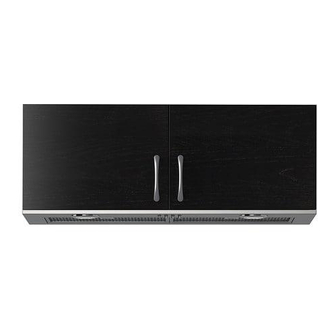IKEA EVENTUELL Instrucciones de instalación y manual de uso y mantenimiento - Página 6
Navegue en línea o descargue pdf Instrucciones de instalación y manual de uso y mantenimiento para Campana de ventilación IKEA EVENTUELL. IKEA EVENTUELL 48 páginas. 30" (76.2 cm) range hood liner

Product Dimensions
A
Cabinet Dimensions
C
E
F
A. 12" (30.5 cm) min. upper cabinet
height
B. 30" (76.2 cm) cabinet opening
width
C. 24" (61 cm) min. from electric
cooking surface, 27" (68.6 cm)
min. from gas cooking surface 36"
(91.4 cm) suggested max. bottom
of cabinet to cooking surface
6
C
B
³⁄₈
A.
" (1.0 cm)
B. 30" (76.2 cm)
C. 26" (66.0 cm)
A
B
D
D. 12" (30.5 cm) min . cabinet depth
E. 15" (38.1 cm) min. clearance
upper cabinet to countertop
F. 36" (91.4 cm) base cabinet height
D
⁷⁄₈
D. 2" (5.1 cm)
G. 11
" (30.2 cm)
³⁄₄
¹⁄₈
E. 10
" (27.4 cm)
H. 9
" (23.2 cm)
³⁄₄
⁵⁄₈
F.
" (1.9 cm)
I. 13
" (34.6 cm)
Venting Requirements
Vent system must terminate to the outside, except for non-
vented (recirculating) installations.
Do not terminate the vent system in an attic or other enclosed
area.
Do not use a 4" (10.2 cm) laundry-type wall cap.
Use metal vent only. A rigid metal vent is recommended.
Plastic or metal foil vent is not recommended.
The length of the vent system and number of elbows should
be kept to a minimum to provide efficient performance.
For the most efficient and quiet operation:
Use no more than three 90° elbows.
Make sure there is a minimum of 24" (61.0 cm) of straight
vent between the elbows if more than 1 elbow is used.
Do not install 2 elbows together.
The vent system must have a damper.
Use clamps to seal all joints in the vent system.
Use caulking to seal exterior wall or roof opening around the
cap.
The size of the vent should be uniform.
Cold weather installations
An additional back draft damper should be installed to minimize
backward cold air flow and a thermal break should be installed to
minimize conduction of outside temperatures as part of the vent
system. The damper should be on the cold air side of the thermal
break.
The break should be as close as possible to where the vent
system enters the heated portion of the house.
Makeup air
Local building codes may require the use of makeup air systems
when using ventilation systems with greater than specified CFM
of air movement. The specified CFM varies from locale to locale.
Consult your HVAC professional for specific requirements in your
area.
I
H
E
G
F
(vented models only)
